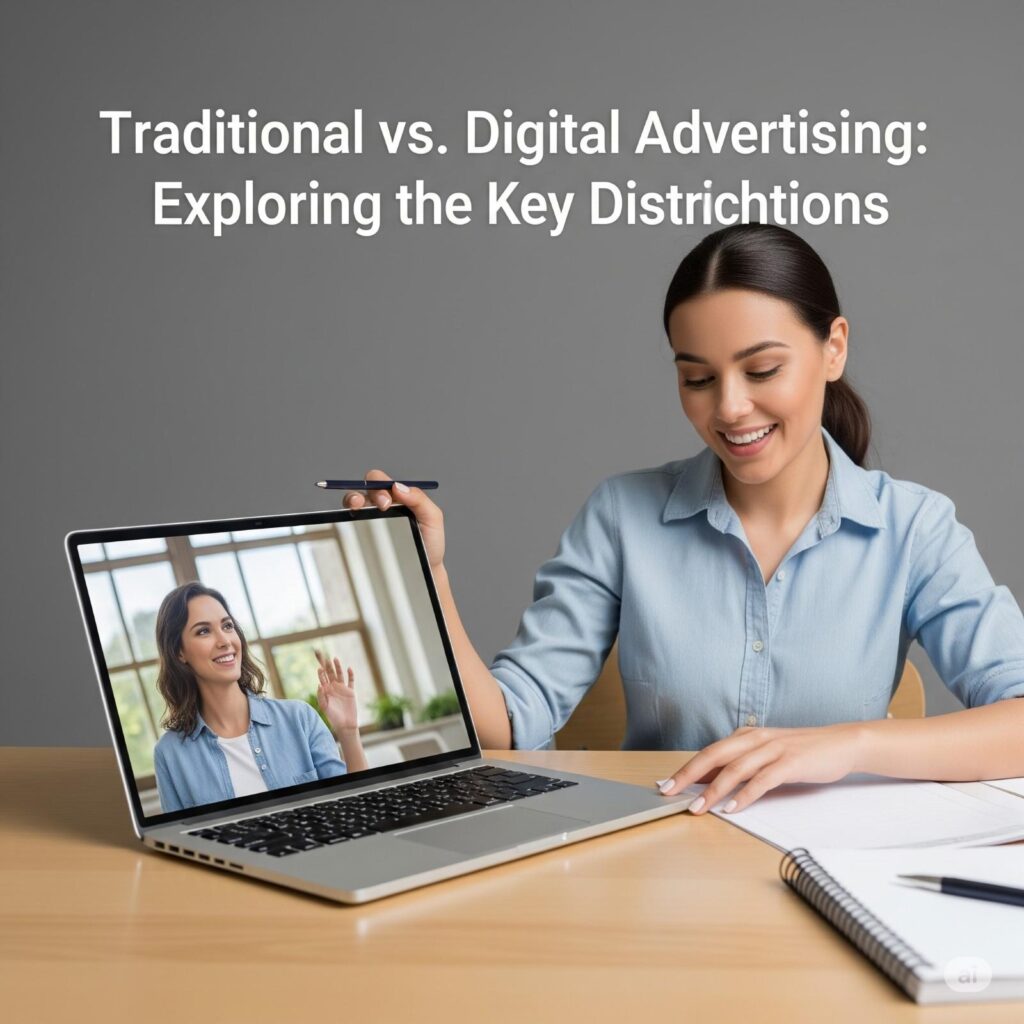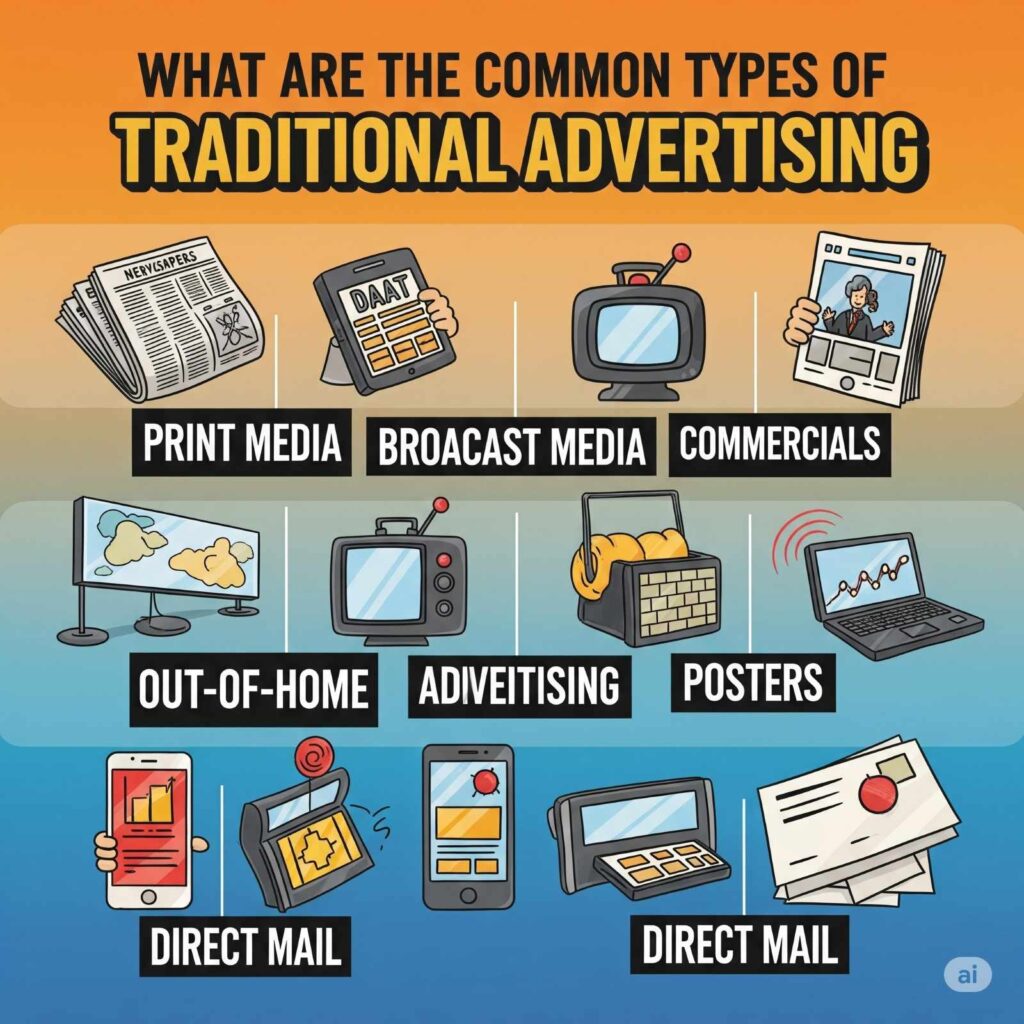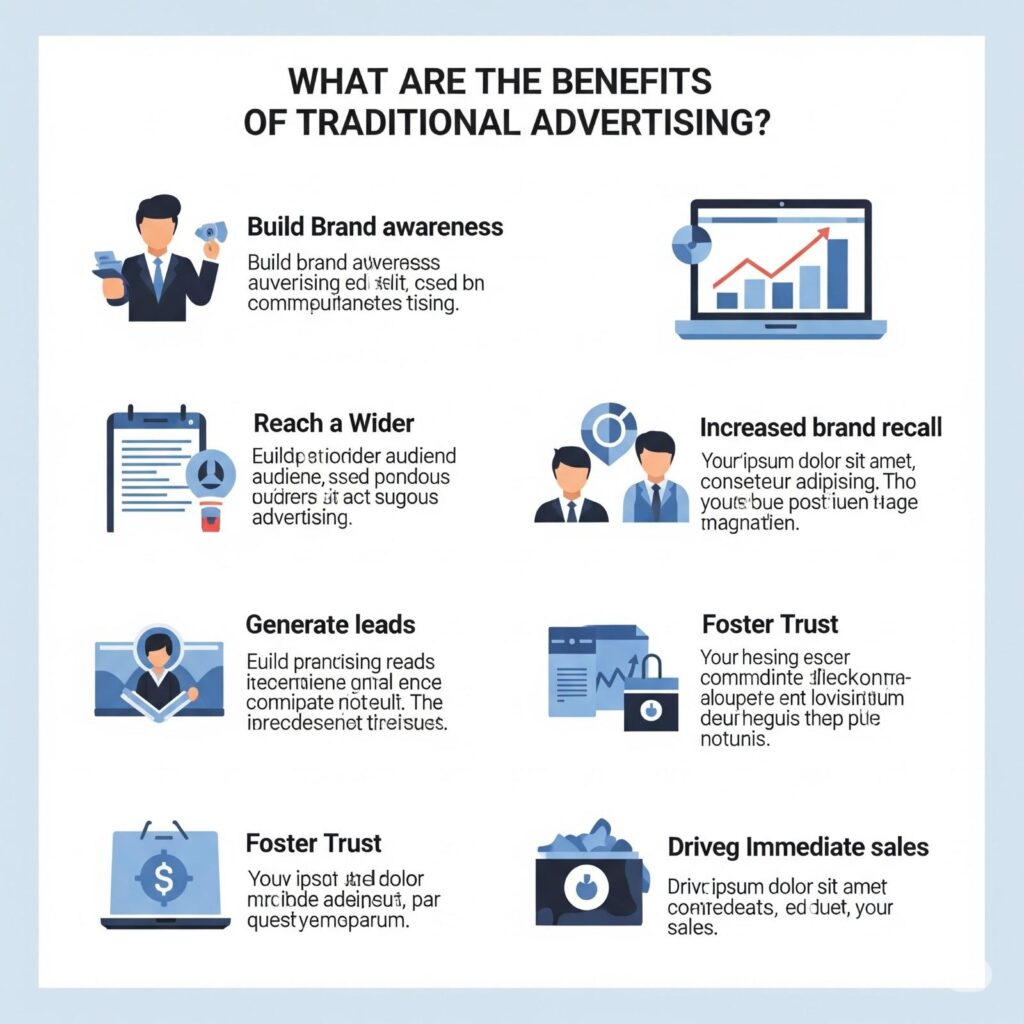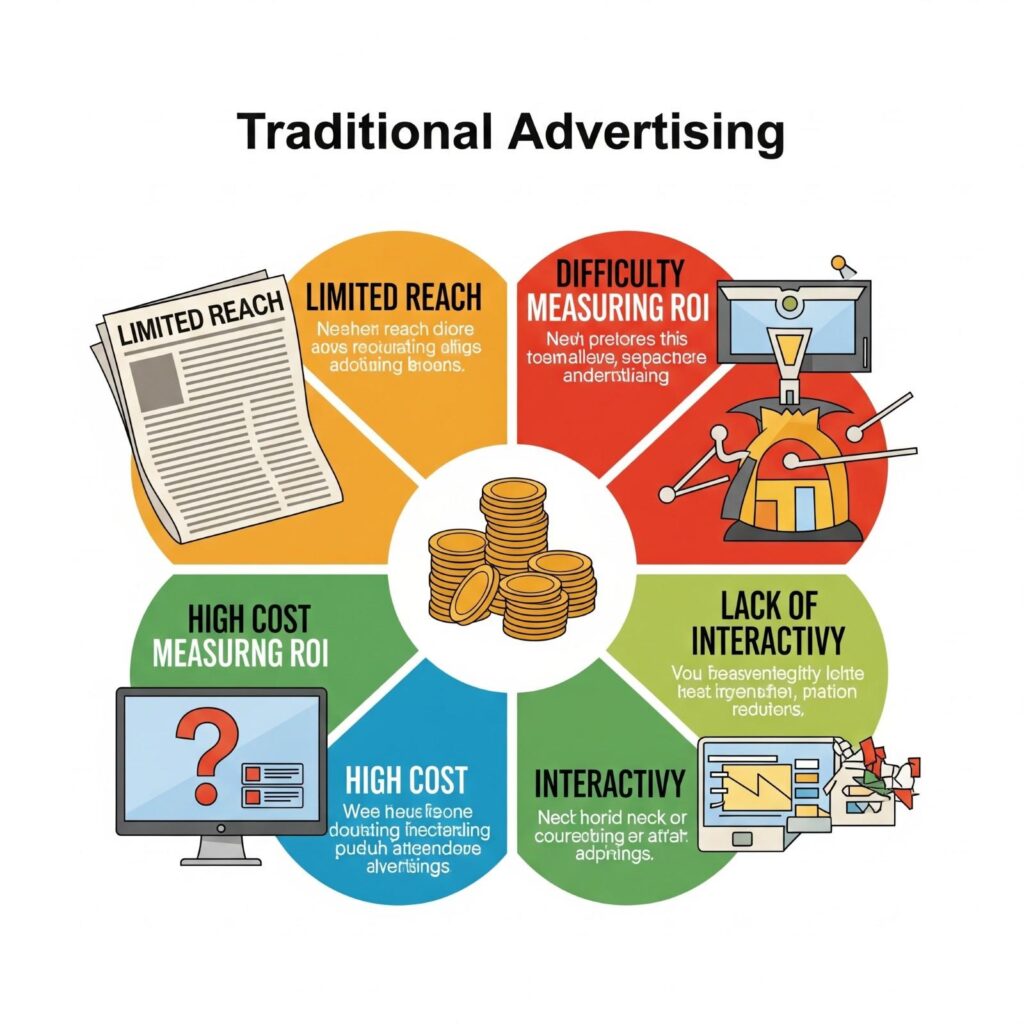We all have those traditions that just make us smile, you know, the little things that spark memories or turn special moments into something even more magical. Some of these are rooted in culture, like wearing specific outfits during festivals. Others are more personal, like passing down names through generations. And let us be real, some traditions leave us scratching our heads like who decided that trifle being a part of Christmas celebrations, and what even is trifle, anyway?
While traditions might seem charming or a bit quirky at times, they definitely serve a purpose, especially in the marketing world.
Smart businesses understand one key thing: traditional advertising remains a powerful strength in their marketing strategy. If you are curious about why that is, here is the scoop on what they have discovered (and what you should keep in mind too).
What is Traditional advertising

Traditional advertising is the classic way of getting the word out about products and services, long before the internet took the spotlight. It encompasses things like TV commercials, catchy radio jingles, newspaper ads, billboards, and flyers. These are the types of ads we remember from our childhood, whether it was watching our favorite shows or humming along to tunes on the radio during a drive.
Even with digital ads dominating the scene today, it still holds a special place in many hearts. People tend to trust these ads, especially when they spot a familiar brand in a newspaper they have been reading for years or on a large banner in their hometown. There is something about these ads that fosters a personal, offline connection that is tough to overlook.
Today’s smart businesses often blend both approaches using digital ads for their speed and targeting capabilities, while relying on traditional advertising for its trustworthiness and broad reach. Together, they ensure that brands remain top of mind, both online and offline.
What are the differences between traditional advertising and digital advertising?

Advertising has always been the focus of every business. However, the methods we use to advertise have transformed significantly over the years. Let us simplify things by comparing traditional advertising with the newer digital approach.
Traditional advertising is the tried-and-true method that encompasses newspapers, radio, TV, magazines, billboards, and flyers. It is the kind of advertising that many of us are familiar with from our childhood. These formats are excellent for connecting with local audiences or reaching broader groups through mediums like television or catchy radio ads. The message remains consistent for everyone, regardless of who is viewing it.
On the flip side, digital advertising takes place in the online area. Whether it is a Facebook ad that blasts up on your phone or a YouTube video that plays before your favorite content, it is all part of the digital scene. The biggest advantage? You can target your audience with precision based on their interests, age, or location. Plus, you can track real-time metrics like clicks and views, which traditional advertising simply cannot provide.
Both methods have their own strengths. Traditional advertising builds solid brand trust, particularly with older customers.
What are the Common Types of Traditional Advertising?

Traditional advertising has been a staple for decades, helping brands connect with people through everyday media. Even with the rise of digital ads, these classic methods still have their place.
Here are some of the most common types of traditional advertising:
1. Newspaper and Magazine Ads:
Print media stands as one of the earliest advertising platforms. Newspapers and magazines have been helping businesses reach both local and national audiences for years. It is a trusted method, especially for those who love their morning paper or favorite magazine.
2. Television Commercials:
TV ads pack a punch because they blend visuals, sound, and storytelling. Whether it is during a cricket match or a family show, television commercials quickly grab attention and leave a lasting impression.
3. Radio Advertising:
Think about those catchy jingles you find yourself humming while driving. Radio ads are fantastic for reaching people on the move. They create brand recall with memorable sounds and straightforward messaging.
4. Billboards and Outdoor Ads:
Big, bold, and right in your face that’s the allure of billboards and hoardings. From highways to bustling city streets, outdoor advertising ensures your message is seen by thousands every day.
5. Flyers and Brochures:
Handouts like flyers and brochures are still popular for local businesses. They are budget-friendly, easy to distribute, and perfect for sharing offers, events, or shop openings.
While traditional advertising may not be as quick as digital, it builds trust, especially among those who prefer familiar platforms. For many businesses, blending these classic methods with modern online advertising proves to be the most effective approach.
What Are the Benefits of Traditional Advertising?

Even in our tech-smart world, traditional advertising still holds a significant place in how businesses engage with their audience. From newspapers to billboards, these time-tested methods come with several real advantages.
Let us dive into the main advantages of traditional advertising, particularly when it comes to print materials and other offline channels.
1. Tangible and Trustworthy:
One of the standout features of print products like newspapers, brochures, and magazines is their physical presence. People can pick them up, read them in their free time, and even pass them along to friends. This creates a level of trust that online ads sometimes struggle to achieve.
2. Great for Local Reach:
For businesses targeting to connect with local communities, traditional advertising is incredibly effective. Newspaper ads and flyers are ideal for promoting local shops, events, or special deals in a specific neighborhood.
3. Builds Brand Credibility:
When people see a brand in TV commercials, radio spots, or print materials, it gives the impression of being well-established. This is why major brands continue to invest in these channels; they foster long-term trust and credibility with audiences of all ages.
4. Reaches a Wider Age Group:
While online platforms often focus on younger demographics, traditional advertising spans across generations. Many older adults still enjoy reading newspapers or watching TV, making these channels perfect for reaching a diverse audience.
5. Longer Shelf Life:
Print products do not just vanish with a swipe. A brochure or magazine can linger on a coffee table or desk for weeks, providing repeated exposure to the brand without the need for additional ad spending.
Traditional advertising might seem a bit old-school to some, but when executed thoughtfully, especially with high-quality print materials, it delivers real, lasting results. Plus, when paired with digital ads, it creates a well-rounded marketing strategy.
Limitations of Traditional Advertising

While traditional advertising has certainly been a key part of brand building over the years, it does come with its fair share of challenges. Understanding these limitations can help businesses make more informed decisions when planning their marketing strategies.
But like everything, traditional advertising has its challenges too. Here are a few of them:
1. Higher Costs:
Creating TV commercials or printing ads in newspapers can be quite pricey. These expenses can pile up quickly, especially for smaller businesses. Plus, once you have shelled out the cash, making changes to your ad can be either costly or, in some cases, impossible.
2. Hard to Track Results:
One of the major drawbacks of traditional advertising is the difficulty in measuring its effectiveness. Unlike digital ads, where you can track clicks, views, or sales, it is challenging to know how many people took action after seeing a billboard or hearing a radio location.
3. Limited Targeting Options:
With traditional advertising, your message is broadcast to everyone, no matter what of their interest. You cannot narrow down your audience like you can with online ads, which means your message might not always reach those who genuinely care about what you are offering.
4. Slower to Launch Compared to Digital Ads:
Getting a print ad or TV commercial off the ground takes time. From the design phase to printing or filming, it is a lengthy process. In contrast, digital ads can be up and running in just minutes, making traditional advertising feel sluggish when you need to promote something quickly.
Despite these challenges, traditional advertising still holds value, especially for building trust and connecting with local audiences. The trick is knowing when to use it and how to blend it with modern marketing techniques.
Speak to the Advertising Experts
If you want your business to thrive, having the right guidance is crucial. When it comes to crafting effective marketing campaigns, consulting with real advertising experts can truly make a difference.
These days, many brands chase online ads, but traditional advertising still has its place. Why is that? Because it connects with people in ways that digital sometimes cannot. Experts who are well-skilled in print media, TV commercials, and radio advertising spots know how to build trust and capture attention where it counts.
Successful marketing campaigns are not just about being online. A blend of traditional advertising like local newspapers, eye-catching billboards, or memorable radio catchy tunes can help you reach audiences you might otherwise overlook.
By collaborating with advertising professionals, you get the best of both worlds. They will refine your traditional advertising strategies to ensure your business connects with real people and delivers real results.
So, if you are eager to create campaigns that leave a lasting impression, it is time to chat with those who know how to bring your vision to life.
FAQs About Traditional Advertising
What is traditional advertising?
Traditional advertising refers to the old, familiar methods of promoting products and services. This means ads in newspapers, magazines, TV, radio, roadside billboards, and handout leaflets. It is been used for decades to help businesses reach customers offline.
2 Is traditional advertising still effective today?
Yes, traditional advertising is still effective, especially for businesses that want to target local areas or older audiences who trust print and TV more than online ads. Many big brands still use it to build credibility and reach larger groups.
3 What are the main advantages of traditional advertising?
The biggest benefits are trust, physical presence, and wide reach. Ads in newspapers and on TV can make your brand seem more reliable and well-known. Plus, a brochure or flyer can stay with someone longer than a digital ad they scroll past.
4 What are the limitations of traditional advertising?
Some common challenges include higher costs, difficulty in tracking results, limited targeting options, and slower campaign launch times compared to digital advertising. That is why many businesses use both traditional and digital together for better results.
5 How can I choose between traditional and digital advertising?
It depends on your audience and goals. If you want local reach or to build strong brand trust, traditional advertising is a good choice. If you need fast, targeted results, digital advertising works better. Many winning marketing campaigns use both together to get the best results.
